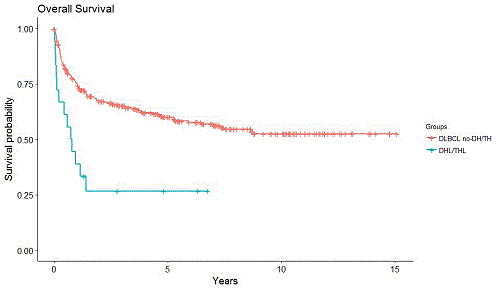
Contributions
Abstract: PB1726
Type: Publication Only
Background
Five to 15% of patients with diffuse large B cell lymphoma (DLBCL) present MYC and BCL2 and/or BCL6 rearrangements which are detected by fluorescence in situ hybridization (FISH) or standard cytogenetic. This rearrangement defines a subgroup of DLBCL so-called double hit or triple hit lymphomas (DHL/THL) which are included in the 2016 WHO classification revision of lymphoid neoplasm in a new category “High-grade B-cell lymphoma with rearrangements of MYC and BCL2 and/or BCL6”. DHL/THL have an aggressive clinical course and poor response to standard chemotherapy and a median overall survival of 0.2-1.5 years. The best therapeutic option in these patients is not yet well established.
Aims
To evaluate retrospectively the incidence, clinical-biological characteristics, type of treatment, overall survival (OS) and progression-free survival (PFS) of patients diagnosed with DHL/THL and to compare them with patients with DLBCL without double/triple-hit genotype (DLBCL-noDH/TH) in a single institution.
Methods
From January 2000 to April 2016, we analized 18 patients with DHL/THL and 312 patients with DLBCL-noDH/TH. DHL/THL cases were identified using FISH for MYC, BCL2 and BCL6 in the tumor tissue (11 lymph node biopsy, 2 gastrointestinal biopsy, 1 bone marrow biopsy, 3 skin biopsy and 1 cerebrospinal fluid).
Results
The incidence of DHL/THL was 5.5%. The median age was 70 years [range 53-93]. The patients included in DHL/THL group had a higher prevalence of advanced disease and higher IPI (p=0.002). Thirteen patients received anthracyclines containing chemotherapy, 3 citoreductive treatment and 2 palliative care. No stem cell transplantation was performed in any patient as a consolidation therapy. Four out of 13 patients achieved complete remission, 3 patients partial response and 6 patients were refractory. At last follow up, 13/18 patients were dead (11 lymphoma progression; 2 infectious complications). Median follow-up 63 months. OS in DHL/THL was 9 months and in DLBCL-noDH/TH was not reached (p=0.001). The PFS in DHL/THL and in DLBCL-noDH/TH was 5.4 and 63 months, respectively (p<0.001)

Conclusion
Session topic: 20. Aggressive Non-Hodgkin lymphoma - Clinical
Keyword(s): Outcome, DLBCL
Abstract: PB1726
Type: Publication Only
Background
Five to 15% of patients with diffuse large B cell lymphoma (DLBCL) present MYC and BCL2 and/or BCL6 rearrangements which are detected by fluorescence in situ hybridization (FISH) or standard cytogenetic. This rearrangement defines a subgroup of DLBCL so-called double hit or triple hit lymphomas (DHL/THL) which are included in the 2016 WHO classification revision of lymphoid neoplasm in a new category “High-grade B-cell lymphoma with rearrangements of MYC and BCL2 and/or BCL6”. DHL/THL have an aggressive clinical course and poor response to standard chemotherapy and a median overall survival of 0.2-1.5 years. The best therapeutic option in these patients is not yet well established.
Aims
To evaluate retrospectively the incidence, clinical-biological characteristics, type of treatment, overall survival (OS) and progression-free survival (PFS) of patients diagnosed with DHL/THL and to compare them with patients with DLBCL without double/triple-hit genotype (DLBCL-noDH/TH) in a single institution.
Methods
From January 2000 to April 2016, we analized 18 patients with DHL/THL and 312 patients with DLBCL-noDH/TH. DHL/THL cases were identified using FISH for MYC, BCL2 and BCL6 in the tumor tissue (11 lymph node biopsy, 2 gastrointestinal biopsy, 1 bone marrow biopsy, 3 skin biopsy and 1 cerebrospinal fluid).
Results
The incidence of DHL/THL was 5.5%. The median age was 70 years [range 53-93]. The patients included in DHL/THL group had a higher prevalence of advanced disease and higher IPI (p=0.002). Thirteen patients received anthracyclines containing chemotherapy, 3 citoreductive treatment and 2 palliative care. No stem cell transplantation was performed in any patient as a consolidation therapy. Four out of 13 patients achieved complete remission, 3 patients partial response and 6 patients were refractory. At last follow up, 13/18 patients were dead (11 lymphoma progression; 2 infectious complications). Median follow-up 63 months. OS in DHL/THL was 9 months and in DLBCL-noDH/TH was not reached (p=0.001). The PFS in DHL/THL and in DLBCL-noDH/TH was 5.4 and 63 months, respectively (p<0.001)

Conclusion
Session topic: 20. Aggressive Non-Hodgkin lymphoma - Clinical
Keyword(s): Outcome, DLBCL


